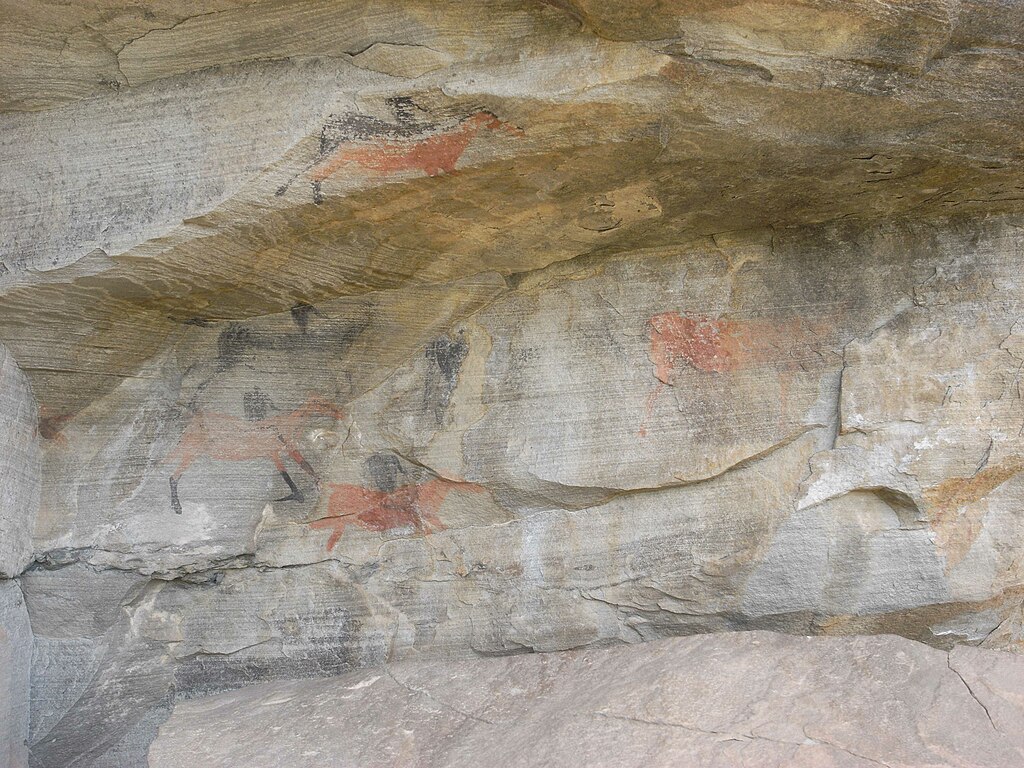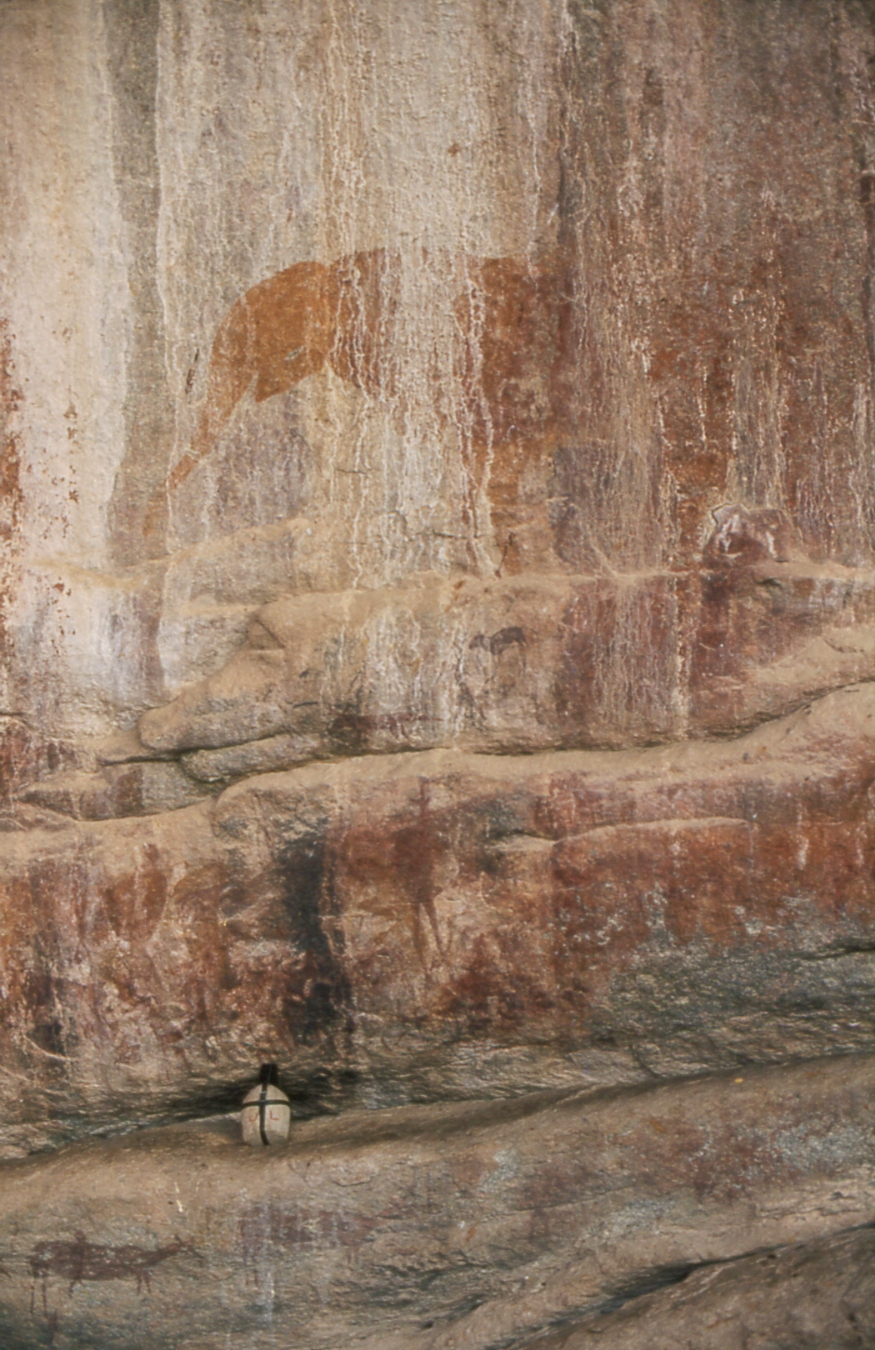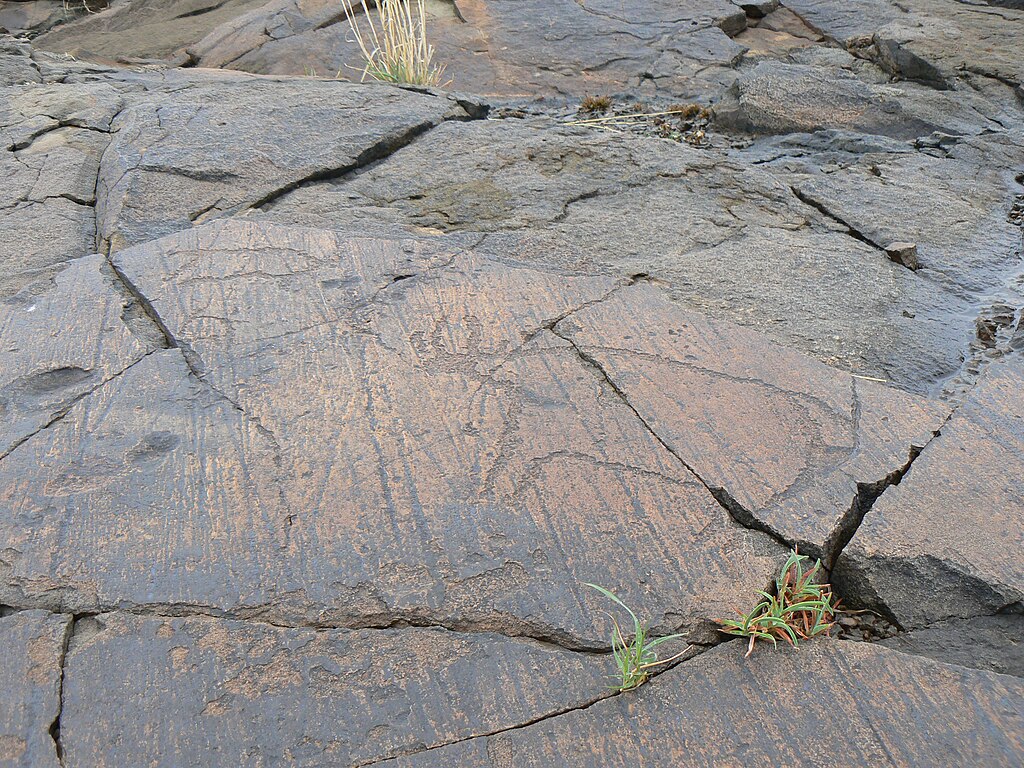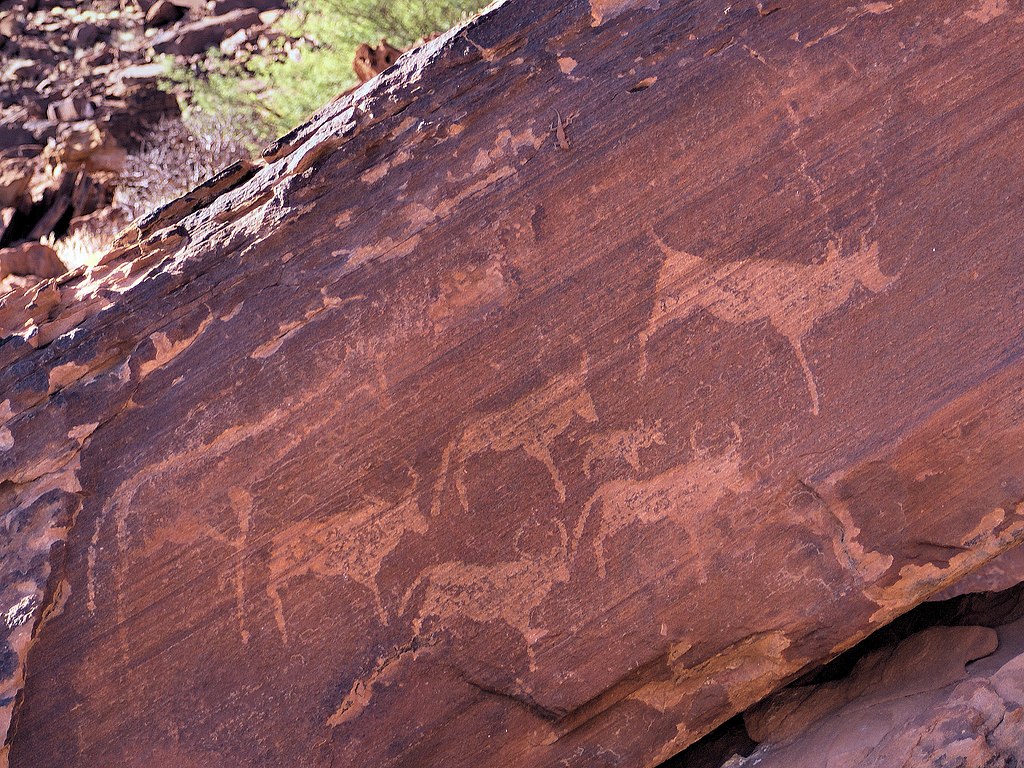
Rock paintings from the Western Cape, Cederberg, South Africa: photo by Jimfbleak, 2007
"... the marks on the bottom of a pewter plate tell the story of all the meals it has been used for.

Sandstone with Bushmen rock paintings, Karoo System, Amathole Mountains, South Africa: photo by Lysippos, 16 November 2008
"In the same way, the form of every piece of land -- the shape of its sand dunes and rocks -- contains in natural script the history of the earth; every rounded pebble that the ocean casts on the shore could tell that story to a soul that is chained to it, as our soul is chained to our brain." -- Said to be found in Lichtenberg, Schriften [Writings], volume 1, p. 223.

Stone Age paintings of the San, found near Murewa, Zimbabwe: photo by Ulamm, 1983
What is certain is that childhood chains us to things in this way; indeed, it may be that in childhood we wander through the world of things like the stations of a journey of whose extent we can form no conception.

(Khoi) San engraving of an Eland on glacial pavement at Nooitgedacht, near Kimberley, Northern Cape, South Africa: photo by Keilmesser, 11 October 2009
Couldn't it be the case that childhood makes a start with the most remote things?

San (the "dancing" Kudu) and Khoekhoen (the abstract figures) rock paintings at Twyfelfontein, Namibia: photo by Hans Hillewaert, 21 June 2007
At first, at the moment of birth, it makes itself similar to the most distant things in the deepest, unconscious stratum of its own existence, so as subsequently to enable the objects of the worlds around to accrete, layer by layer.

Stone Age paintings of the San (1000-to-2000 years old), found near Murewa, Zimbabwe: photo by Ulamm, 1983
Hence, what education and human influence do is only one factor in a field of many other forces -- forces the child responds to with that gift of mimesis which was the natural heritage of mankind in its early stages and which continues to function nowadays only in children.

Bushmen rock painting [drum and warriors?], Zimbabwe: photo by Steve Evans, 1 March 2005
The gift we possess for seeing similarity is nothing but a feeble vestige of the formerly powerful compulsion to be similar and to behave mimetically.

Rock Painting of Giraffe, Sossusvlei Desert Lodge, NamibRand Nature Preserve: photo by Namibnat, 26 September 2008
And the now-vanished ability to become similar reached beyond the narrow world of perception in which we are still able to perceive similarity.

Rock paintings on a private farm outside George, South Africa: photo by Cazo3788, 30 December 2005
Millennia ago, the effect of the stars upon a man's life at the moment of his birth was woven into his life, on the basis of the similarity by which the spirits and forces of life were shaped in accordance with a model that was inscribed in the cosmos.

San / Bushman rock painting of an Eland, Ukalamba Dragensberge, South Africa: photo by Lukas Kaffer, 6 August 2007
It is possible, or even probable, that the formative powers familiar to recent generations are no longer able to extend their influence so far.

San rock art at at Twyfelfontein, Namibia: photo by Hans Hillewaert, 21 June 2007
And am I mistaken when I maintain that I have formed in me the image of chairs, stairwells, cupboards, net curtains, and even a lamp -- objects that surrounded me in my childhood?

Ancient Bushman rock painting, Spitzkoppe, Namibia: photo by Katxijasotzaile, 30 September 2006
We must reckon with the fact that, basically, even events in the sky could be imitated by people in earlier times.

Spitzkoppe, Namibia: photo by Falense, 2 April 2006
Modern man can be touched with a pale shadow of this when he looks through a mask, or when, on southern moonlit nights, he feels mimetic forces alive in himself that he had thought long since dead, while nature, which possesses them all, transforms itself to remember the moon.

Spitzkoppe, Namibia : photo by Thomas Schoch, 25 August 2003
But he is transported into this very force field by his memories of childhood.

Bushmen hunting for porcupine, outside the village of Doupos, east of Tsumkwe, Nyae Nyae Conservancy, North East Namibia: photo by David Barrie, 6 July 2008
The gift we possess for seeing similarity is nothing but a feeble vestige of that powerful compulsion to become similar and to behave mimetically.

The daughters of a small community of bushmen living in Namibia: photo by Nicolas M. Perrault, 18 July 2009
Walter Benjamin: extract from The Lamp, a fragment composed in early 1933 and unpublished in the writer's lifetime. Translated by Rodney Livingstone in Walter Benjamin: Selected Writings, Volume 2: 1927-1934 (1999)



6 comments:
Tom,
". . . in childhood we wander through the world of things like the stations of a journey of whose extent we can form no conception."
". . . even events in the sky could be imitated by people in earlier times."
". . . seeing similarity is nothing but a feeble vestige of that powerful compulsion to become similar and to behave mimetically."
1.3
light coming into fog against invisible
plane of ridge, motionless black leaves
in foreground, sound of wave in channel
graphic, “idea continues to”
version of subject in
what else but that to which,
following, is “being”
grey white of fog against top of ridge,
cormorant flapping across toward point
me-thinks that those dates
"1000-2000 years ago" sld be
"10,000-20,000 years ago" and more probably be:yond even 20,000 B.C.?
these images come in at a good time (for me) as I have just
"inhaled" Herbert Kuhn's "On the Track of Prehistoric Man"
:trying to get into more than just an hint of
any images of my 'gal' in my Stone Girl E-pic ?
again Tee See
a Rock Solid post !
Steve,
There's a link here somewhere...
what else but that to which,
following, is “being”
Ed,
The hunter-gatherer San people are thought to have executed the rock paintings of Southern Africa in the late Stone Age period, generally considered to have begun c 50,000 years ago.
Genomic studies of different peoples around the world done in the 1990s showed the Y chromosomes of men from several San tribes to be distinct from the genomes of all other populations. The authors of these studies suggested that the San may have been one of the first populations to differentiate, by patrilinear descent, from the most recent common paternal ancestor of all extant humans, the so-called Y-chromosomal Adam (estimated to have lived between 60,000 and 90,000 years ago).
A study of African genetic diversity completed in 2009 found the San people were among the five populations with the highest measured levels of genetic diversity among the 121 distinct African populations sampled. The San are one of 14 known extant "ancestral population clusters" (from which all known modern humans evolved).
Radiocarbon dating of San rock paintings in the Apollo II Cave in Namibia yield a date of 23,000-25,000 BCE.
By some estimates the Late Stone Age period ended c. 8000 years ago, with the origins of metalworking.
But the calculated temporal extent of the Late Stone Age is different in different regions. Some hunter-gatherers (like the San) continued to work with stone, not metal, as late as several thousand years ago.
In the Drakensberg lavas of South Africa (deposited between 45 and 208 million years ago), rock paintings were done over a period of c. 4000 years, the latest dated to c. 3000 years ago.
Some good images from Drakensberg in this slide show:
uKhahlamba / Drakensberg Park
The attribution you have questioned raised doubts in my mind as well. Did the author of the attribution mean to say "between 20,000 and 10,000 years ago", rather than "between 2000 and 1000 years ago"?
As a matter of practise I don't fiddle with authorial photo-attributions unless I can discover solid evidence in favour of revision.
So I guess I'll fudge a bit and just let the attribution say "Stone Age".
(The subject of that painting, by the way, appears to be an elephant.)
well
as y'all know:
however
I suspect that there is an huge & probable
Ancient "Religious" or ceremonial or
initiational
meaning/use to them cave paintings
images and near-image guiding ...brings into the Oterer EWorld..
into the Underworld into the Unconcious realm?
a shaman in a bear-skin or in a deer or bison skin...
follow on your belly that Snake Goddess down the hole... down the Rabbit Hutch-Door
deep-down into Mother...
Sacred Animals guiding us, feeding,us, clothing us !
& then we had to go and invent a "god" that looks like man and destroy .... The Mystery/Magic.
anyway
this-all (the paintings on rock-walls where done because
they wanted this important "stuff" to last "forever"
"It is written in stone"
et cetera...
Having recently read David Lewis-William's book, The Mind in the Cave, and presently in the process of applying for an artist residency program exploring and developing alternative intuitions of what mimesis could be, I found this post to be intriguing and timely. Have been drawn to this subject in my own artwork for years.
David Lewis-Williams on the South African San rock art:
"...the painters actualized the tiered cosmos and their journeys through it, I argue that the three levels were not merely conceptual: they were manifest in the rock shelters. The painted images of another world made sense because of their location on the 'veil', the interface between materiality and spirituality. The rock wall on which paintings were placed was not a "tabula rosa" but part of the images: in some ways, it was the support that made sense of the images. Art and cosmos united in a mutual statement about the complex nature of reality."
Holly,
That's a marvelous quote from David Lewis-Williams, gets right to the heart of what this post is about.
And as for your own pursuit --
"...exploring and developing alternative intuitions of what mimesis could be.."
It was thoughts along those same lines that led me counterpose Benjamin's developing theory of mimesis with the praxis of the San.
Still thinking about it, and glad to hear I'm not alone in these thoughts.
And speaking of praxis -- looking at those big beautiful paintings of yours, I can see that for you this is not merely a theoretical question, but a working interest.
The exploration continues...
Post a Comment